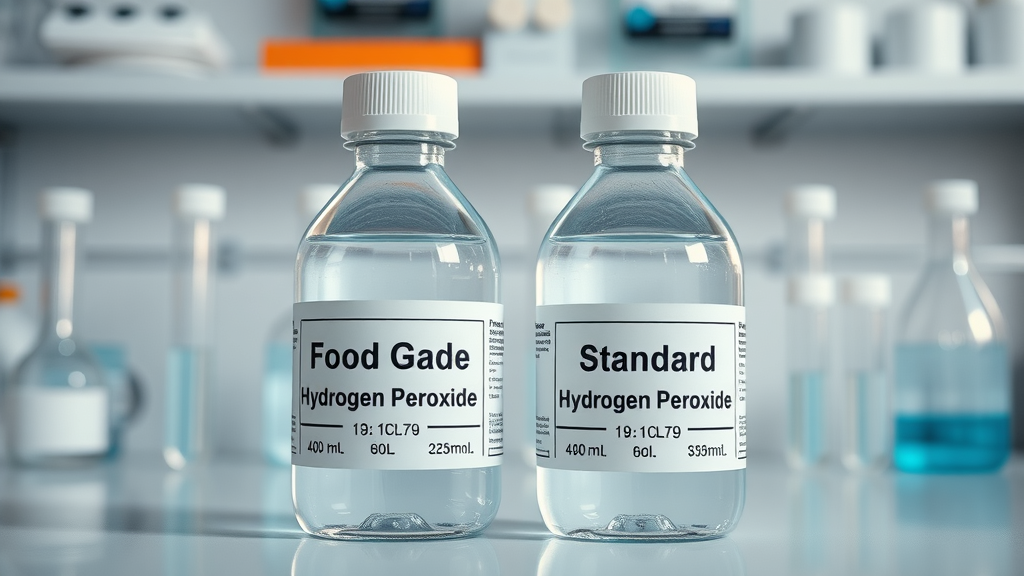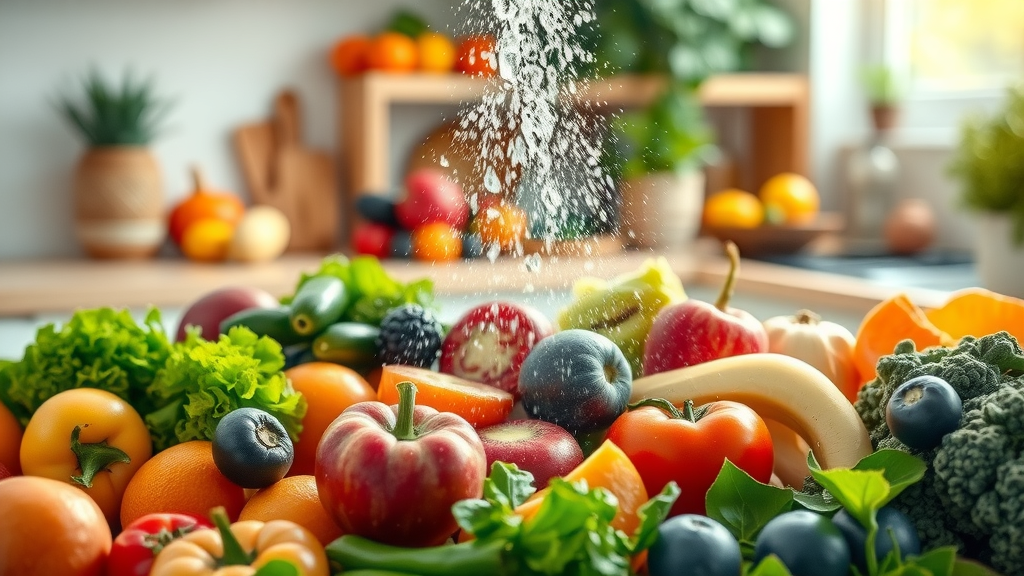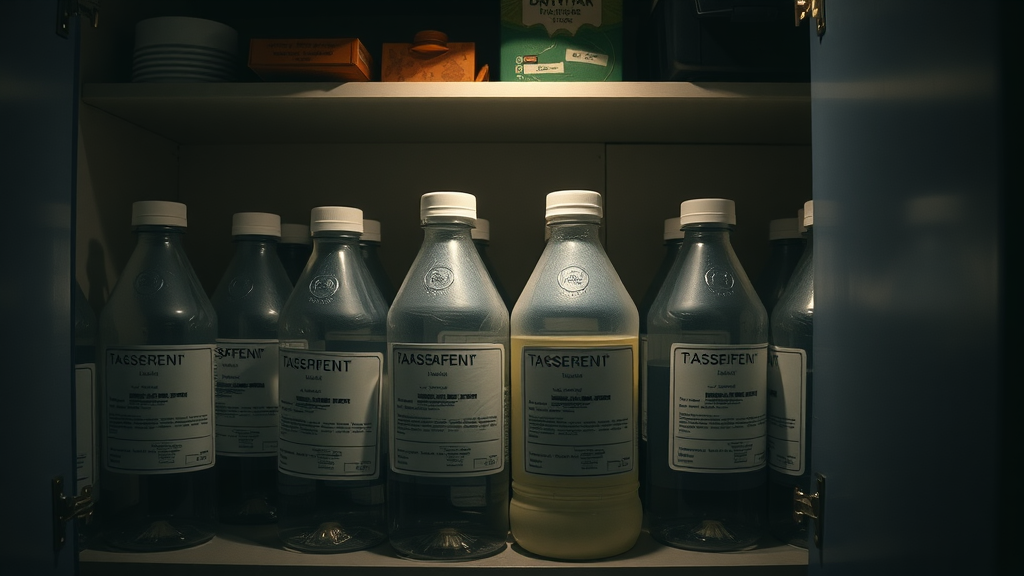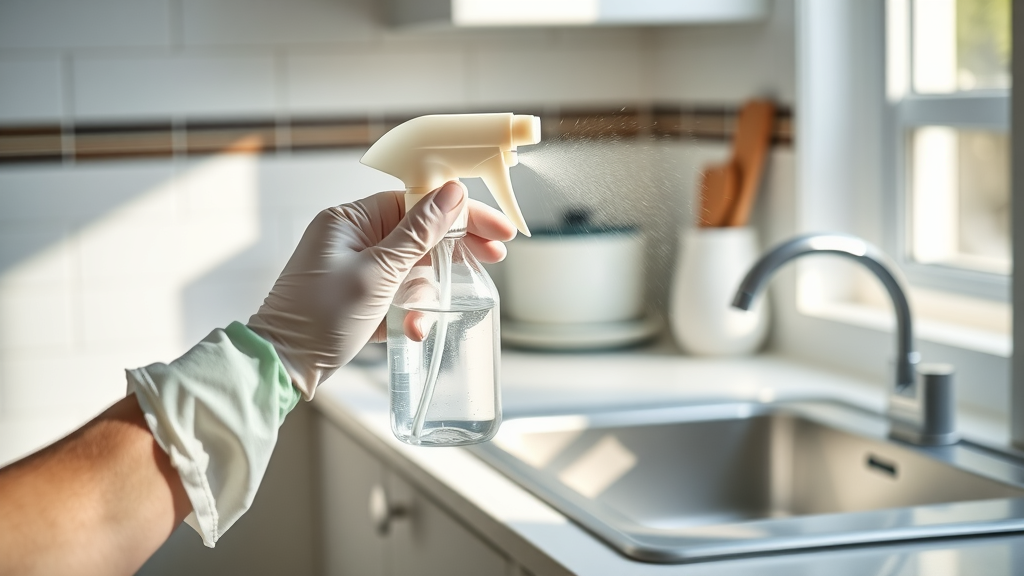Did you know over 50% of people incorrectly use standard hydrogen peroxide instead of the far purer, food grade version? This common mistake can cost more than you think, affecting both your health and the effectiveness of cleaning or food safety tasks around the home. Whether you’re considering hydrogen peroxide for sanitizing produce, oral care, or natural cleaning, understanding the crucial differences—and how to handle food grade hydrogen peroxide safely—is essential. In this in-depth guide, we’ll unravel science, expose myths, and give you expert-backed insights so you can use food grade hydrogen peroxide with total confidence.
Unlocking the Truth About Food Grade Hydrogen Peroxide: Startling Facts and the Science Explained
Food grade hydrogen peroxide isn’t your ordinary brown bottle from the pharmacy shelf. While both products contain hydrogen peroxide as the active ingredient, their levels of purity and safety for use around food and in personal care applications are drastically different. Armed with startling statistics and core facts, this section lays out exactly what food grade hydrogen peroxide is, why its formulation matters, and how you can avoid the critical mistake of confusing it with standard hydrogen peroxide.
Understanding why more than half of people mix these products up starts with their packaging. Food grade hydrogen peroxide typically comes in higher concentrations—often 35%—and is free from toxic stabilizers found in the 3% household version. Only when diluted correctly with distilled water does food grade hydrogen peroxide become a powerful—and safe—solution for cleaning, food prep, and even limited oral hygiene uses. Get ready to see how scientific purity and practical application combine to make food grade hydrogen peroxide a truly exceptional option for modern households.

A Surprising Statistic: Over 50% of People Mistake Standard Hydrogen Peroxide for Food Grade
Confusion between food grade hydrogen peroxide and standard hydrogen peroxide is alarmingly widespread. According to consumer surveys, more than half of users have used regular hydrogen peroxide for food-related or alternative health uses without realizing it was not appropriate. This simple error can expose users to toxic stabilizers and harsh impurities, undermining their efforts to sanitize food products or perform personal care safely. With both products sharing similar packaging (white or clear bottles), it’s vital to check the concentration and verify the label every time.
This confusion can lead not only to health risks but also to reduced efficacy in important tasks like disinfecting organic produce or safely cleaning surfaces for food preparation. Educating yourself on the exact bottle to use, the concentration to look for, and the way to dilute it avoids dangerous mistakes and puts you in control of household hygiene and safety.
What Sets Food Grade Hydrogen Peroxide Apart in Everyday Use?
The principal difference between food grade hydrogen peroxide and ordinary hydrogen peroxide is their purity and absence of additives. While standard variants often contain stabilizers that could be harmful if ingested or left on food products , food grade hydrogen peroxide is pure and specially produced for applications involving food or surfaces that come into contact with food. This purity turns a typical bleaching agent into a versatile powerhouse for essential oxygen applications at home.
Beyond safety, food grade hydrogen peroxide boasts a greater shelf life when stored properly, increased cleaning power at the proper dilution, and an ability to be used in ways that are off-limits to standard peroxide solution. The result? You gain a non-toxic alternative for many routine tasks—provided you respect the safe handling rules detailed throughout this guide.
Discover What You'll Learn About Food Grade Hydrogen Peroxide in This Guide
A comprehensive understanding of food grade hydrogen peroxide versus household hydrogen peroxide
Safe and approved uses for food grade hydrogen peroxide
Critical safety practices for handling and diluting food grade hydrogen peroxide
Debunking myths surrounding hydrogen peroxide and food grade hydrogen peroxide solution
Expert insights and frequently asked questions about hydrogen peroxide use
Food Grade Hydrogen Peroxide vs. Standard Hydrogen Peroxide: Key Differences
There is a world of difference between food grade hydrogen peroxide and the standard solution you find in most medicine cabinets. While both function as disinfectants and oxidizers, only the food grade version is free from toxic stabilizers. This higher purity allows it to be used on food products , in distilled water for safe sanitizing, and in select personal care product routines. However, these benefits come with essential safety checks, namely the risk posed by improper dilution or misapplication.
In this section, we’ll detail the unique features and advantages of each type while emphasizing approved uses, concentration strengths, and ways to avoid dangerous mistakes.
What is Food Grade Hydrogen Peroxide? Definition, Purity, and Food Safety
Food grade hydrogen peroxide is defined by its high purity (usually 35%) and its lack of added chemicals like phenol, acetanilide, and other contaminants. These stabilizers, found in standard hydrogen peroxide, make regular versions unsuitable for food -oriented tasks. By contrast, food grade hydrogen peroxide is manufactured under stricter controls and designed for everything from sanitizing produce to certain forms of water treatment . No matter the use, the absence of toxic stabilizers ensures a cleaner, safer experience—provided you handle and dilute it correctly.
This version’s superior purity brings two primary advantages: the absence of side effect-causing additives and the ability to break down into only water and oxygen as it acts. This makes food grade hydrogen peroxide a favorite in both eco-friendly cleaning routines and in the preparation of organic or sensitive food products where residues must be avoided.
Nevertheless, its higher concentration means users must practice caution and follow all label and dilution instructions—direct skin contact or accidental ingestion of undiluted grade hydro can lead to burns or internal injury. Always keep the container clearly labeled and stored well away from children or unsuspecting users.
How Does Grade Hydrogen Peroxide Differ From Regular Hydrogen Peroxide Solution?
The distinction between food grade hydrogen peroxide and regular hydrogen peroxide solution is about both concentration and composition. Household hydrogen peroxide is generally sold at 3% concentration, stabilized with chemicals to prolong shelf life and prevent spontaneous breakdown. This renders it more suited for first aid, simple cleaning, and stain removal, not for food or any usage where ingestion might accidentally occur.
Food grade hydrogen peroxide, on the other hand, is not simply “stronger.” It’s also devoid of stabilizers and fillers, meaning its decomposition leaves no toxic residue. This makes it perfect for washing fruits and vegetables when diluted, or for certain water treatment processes where clean, pure oxygen release is required. Both products oxidize effectively, but only food grade hydrogen peroxide is approved for contact with food products and sensitive applications, always with attention to proper storage, dilution, and use.
Using the wrong product in the wrong way—even in small amount—can cause not just side effects like irritation, but also introduce toxic chemicals into your system or onto your food. Always cross-check concentration, labeling, and the presence of “food grade” purity before trusting any hydrogen peroxide for applications close to your body or your diet.
Comparison Table: Food Grade Hydrogen Peroxide vs. Regular Hydrogen Peroxide vs. Peroxide Solution | |||
Attribute |
Food Grade Hydrogen Peroxide |
Regular Hydrogen Peroxide |
Peroxide Solution |
|---|---|---|---|
Purity |
Typically 35%, No Toxic Stabilizers, Food Safe |
3%, Stabilizers & Impurities Present |
Variable, Often Low Purity |
Approved Uses |
Food sanitizing, produce wash, |
First aid, home cleaning, stain removal |
Mainly cleaning and industrial use |
Safety |
Needs strict dilution; |
Relatively safe at low concentration but not for ingestion |
Rarely safe for home or food use |

Understanding the Uses of Food Grade Hydrogen Peroxide
The uses of food grade hydrogen peroxide are broad and impressive—but only if you know the correct ways to apply and dilute it. In both home and professional kitchens, food grade hydrogen peroxide shines as a safe-yet-powerful method for sanitizing produce , disinfecting surfaces, and improving water quality. Thanks to its high purity (when controlled and diluted), this product also finds roles in personal care and even certain alternative health routines. Below, you’ll discover everyday practical examples, as well as expert advice on getting the most out of your bottle.
Not all hydrogen peroxide uses you see online are safe or approved, however. Only the food grade product—properly diluted using distilled water —is acceptable for any application with direct food or personal contact. Keep reading for the definitive checklist.
Essential Oxygen Applications: Approved and Off-Label Food Grade Hydrogen Peroxide Uses
Using food grade hydrogen peroxide for food sanitizing and produce washing
Grade hydrogen peroxide in home cleaning and surface disinfection
Food grade hydro and distilled water for safe dilution in daily use
Personal care routines: mouth rinses, oral hygiene, and skin care
Top uses of food grade hydrogen peroxide include the safe washing of fruits and vegetables (removing bacteria and pesticides that basic water can leave behind), as well as disinfecting kitchen counters and utensils. When diluted correctly, it transforms otherwise risky raw produce into safer, ready-to-eat snacks, and ensures food prep surfaces are clear of invisible contaminants.
Additionally, food grade hydrogen peroxide finds a niche in personal care as a diluted ingredient for mouth rinses or skin treatments, offering an alternative to harsher commercial care products . Some practitioners of alternative health also pursue its use for water treatment , but this should always be under the guidance of an expert. Remember: always use distilled water for dilution, as impurities in tap water can negate the product’s benefits or even create new risks.

Expert Quote: Food Grade Hydro and Aqueous Solution Safety
“Food grade hydrogen peroxide, when expertly diluted with distilled water, is a versatile and powerful non-toxic cleaner. - Dr. Jane Feldman, Toxicologist”
Safe Handling, Storage, and Dilution of Food Grade Hydrogen Peroxide
Safeguarding yourself and your household starts with correct storage, careful mixing, and respecting the powerful oxidizing ability of food grade hydrogen peroxide. Failure to do so brings highest risk of chemical burns, eye injuries, or accidental poisoning. This section covers best practices for storing, handling, and diluting your bottle, with actionable tips for maximizing effectiveness and minimizing risk in every application.
Always remember: food grade hydrogen peroxide at high concentrations is a hazardous chemical—not an everyday household supply. Treat it with respect, and you’ll empower safer, healthier home routines.
Proper Storage Requirements for Food Grade Hyd
How to store food grade hydrogen peroxide away from heat and light
Protecting food grade hy containers from accidental spills
Food grade hydrogen peroxide must be stored in a cool, dark place, preferably in its original, opaque container. Exposure to heat or sunlight accelerates oxidation and can degrade the product—or worse, cause pressure buildup and container rupture. Always keep the cap tightly sealed, and never store the bottle where children or pets can reach it. For added safety, clearly label the container and keep it in a locked cabinet.
To prevent accidents, place bottles upright and ensure all containers are compatible with oxidizers. If a spill occurs, dilute immediately with large quantities of water and ventilate the area. Never transfer food grade hydro to unmarked or clear bottles, as this can lead to disastrous confusion in a busy home or workspace.

Safe Dilution: Mixing Grade Hydrogen Peroxide with Distilled Water
The exact steps to create usable peroxide solution for household applications
Measuring food grade hydrogen peroxide concentrations for personal care
What to avoid when diluting hydrogen peroxide solution
Always start with the manufacturer’s guidelines for safe dilution. Typically, if using a 35% food grade hydrogen peroxide, you will dilute one part peroxide to ten or more parts distilled water for cleaning or food use; for oral care , even greater dilution is often recommended (such as 1 drop in 1–2 ounces of water). Never use tap water for dilution—it may contain trace metals or impurities that render the peroxide ineffective. And always wear gloves and goggles when handling concentrated solutions, as accidental splashes can cause burns or eye injuries.
Avoid mixing food grade hydrogen peroxide with any unknown chemicals or homemade “recipes” not backed by credible sources. Dangerous gas or toxic byproducts can result, especially in poorly ventilated areas. The safest approach is to prepare only a small amount of dilute solution as you need it, discarding leftovers safely after each use. Aqueous solution strength should be checked with test strips or accurate measuring tools for best results in personal care routines.
List: Critical Dos and Don’ts When Using Grade Hydrogen Peroxide
DO: Always use gloves and eye protection
DO NOT: Mix with unknown chemicals
DO: Rinse produce and surfaces with distilled water after application
Follow these “DOs and DON’Ts” to avoid common mishaps. Protective equipment is essential during both dilution and use, as highly concentrated solutions can cause rapid, painful chemical burns on contact. Never mix food grade hydrogen peroxide with acids, ammonia, or household cleaners—these combinations are unpredictable and potentially deadly. Finally, after using peroxide solution to disinfect produce or surfaces, always rinse with distilled water to remove all traces and limit long-term exposure. This double-layer approach further isolates your food products from unintentional side effects.
Health and Safety Insights: Potential Risks of Food Grade Hydrogen Peroxide
While food grade hydrogen peroxide offers significant benefits, it’s not without serious health and safety risks when mishandled. From caustic burns to systemic toxicity, misuse can transform this useful ingredient into a medical emergency. Let’s debunk persistent peroxide product myths and learn strictly how to avoid the risks most often overlooked by new users.
Medical experts urge respect for this powerful chemical—especially when used outside its food or cleaning roles. If in doubt about any step or application, seek advice from a qualified professional or toxicologist instead of guessing.
Potential Hazards: Food Grade Hydro and Peroxide Product Myths
Why undiluted food grade hydrogen peroxide is never safe for direct use
How overuse of hydrogen peroxide can cause oral and digestive injuries
What doctors say about peroxide product misuse
Despite frequent claims across alternative health forums, undiluted food grade hydrogen peroxide should never touch skin, eyes, or be consumed directly. Even tiny amounts of concentrated solution can erode tissues and cause severe, lasting side effects—ranging from irritation and burns to esophageal injury. Overuse, even of dilute solutions, can lead to mouth soreness, gastrointestinal upset, and disruption of the body’s delicate microbiome if swallowed by accident.
Doctors are unanimous: any perceived benefits rapidly evaporate when users ignore dosage or concentration recommendations. Ingesting food grade hydrogen peroxide, or using it to treat conditions without medical supervision, poses unacceptable risks. Treat it as a powerful cleaning agent with food-safe benefits, not a cure-all.

Quote: Medical Perspective on Food Grade Hydrogen Peroxide
“Even food grade hydrogen peroxide must be used with utmost caution. Self-medicating with high concentrations can be extremely dangerous.” - Dr. Samuel Klein, Emergency Physician
Popular Applications: Food Grade Hydrogen Peroxide in Personal Care and Home Use
Safe and intended use are paramount when incorporating food grade hydrogen peroxide into daily life. With the right approach, it delivers standout results in both oral care and home disinfection—always with strict adherence to dilution and expert guidance. This section dives deeper into the most effective applications and shares actionable best practices for both personal wellness and domestic hygiene.
No matter how you plan to use food grade hydrogen peroxide, remember these core rules: dilute well, apply sparingly, and follow up with thorough rinsing whenever food or skin is involved. Used wisely, it can help remove stains, boost cleanliness, and add an extra margin of safety in the kitchen and bathroom alike.
Personal Care: Using Food Grade Hy for Oral and Skin Hygiene
Best practices for grade hydro mouth rinses
Safety instructions for topical hydrogen peroxide solution use
Many users are drawn to food grade hydrogen peroxide for dental hygiene because of its ability to kill germs and whiten teeth. Always use a heavily diluted aqueous solution —commonly no more than a single drop in one or two ounces of distilled water —and swish gently in the mouth for brief intervals before spitting. Direct contact with gums or prolonged use can degrade enamel and irritate soft tissues, so rinse thoroughly and avoid swallowing.
For skin applications (acne treatment, wound care), use only weakly diluted peroxide and test a small amount on an inconspicuous area first. Watch closely for redness, stinging, or side effects, and discontinue use immediately if you notice discomfort. Medical consensus is overwhelmingly cautionary: hydrogen peroxide, even in food grade form, is not a substitute for professional dental or dermatologic care.
Home Disinfection: Grade Hydrogen Peroxide Benefits for Cleaning
Sanitizing surfaces with diluted food grade hydrogen peroxide
Combating germs naturally with peroxide solution
When correctly prepared, a solution of food grade hydrogen peroxide in distilled water can become your kitchen’s secret weapon against bacteria, viruses, and mold. Use it to wipe down countertops, cutting boards, refrigerator shelves, and even high-touch appliances. A quick spray followed by a wipe and rinse leaves surfaces clean and chemical-free, depositing only water and oxygen behind.
This natural approach is especially prized among those with allergies or sensitivities to artificial cleaners, or anyone who values chemical-free living. Take care: always label bottles and keep solutions away from children, as even diluted peroxide should not be ingested or allowed to linger on hands after cleaning. For the best effect, let the solution stand for several minutes on the surface before rinsing thoroughly with clean water.

People Also Ask: Answers to Common Questions About Food Grade Hydrogen Peroxide
Is it safe to use food grade hydrogen peroxide on teeth?
Answer: Using food grade hydrogen peroxide on teeth can be safe only if properly diluted; undiluted solutions can damage gum and enamel.
Why do doctors say not to use hydrogen peroxide?
Answer: Most doctors caution against using any form of hydrogen peroxide directly in the body because of risks of chemical burns and toxicity.
What's the difference between hydrogen peroxide and food grade hydrogen peroxide?
Answer: Food grade hydrogen peroxide is higher in purity and lacks stabilizers and contaminants, making it more suitable for food-related uses than household versions.
Can you rinse your mouth with food grade hydrogen peroxide?
Answer: It is possible when the hydrogen peroxide is heavily diluted; always consult dental professionals for recommended concentrations.
Best Practices and Pro Tips for Using Food Grade Hydrogen Peroxide
Always read the label for concentration
Start with small test batches for cleaning or personal care
Use only distilled water for dilution
Store out of children’s reach and clearly labeled
Never ingest undiluted food grade hydrogen peroxide
Following these strategies will help protect everyone in your household from the potential harms of misapplication while maximizing the safer, more natural benefits of peroxide solutions for cleaning and health.
Regularly review manufacturer guidelines, refresh your knowledge about safe dilutions, and never assume home remedies seen online are trustworthy without professional support. By starting small and monitoring for adverse reactions, you make food grade hydrogen peroxide a tool—not a threat—for home wellness.
Frequently Asked Questions: Food Grade Hydrogen Peroxide
How should food grade hydrogen peroxide be labeled for storage?
Can food grade hydro be used to preserve food?
What concentration of hydrogen peroxide is considered food grade?
Where can you buy authentic grade hydrogen peroxide?
Food grade hydrogen peroxide should always be stored in opaque, securely capped bottles with a clear label specifying the concentration and the term “food grade.” Only specialized online retailers, chemistry suppliers, and reputable health stores should be trusted for purchasing; always check for third-party lab reports or quality assurances. Never use solutions labeled as “industrial” or without clarity on purity and contents. Standard food grade concentrations hover around 35%, though lower ratios are also available for home use.
As for food preservation, direct use is not generally approved due to the risk of chemical burns and residual peroxide on consumed foods. Approved food-safe applications generally involve rinsing and then thoroughly discarding excess solution with copious fresh water. Familiarize yourself with your product’s specifications, and when in doubt, contact the manufacturer directly.
Fast Facts and Key Takeaways on Food Grade Hydrogen Peroxide
Food grade hydrogen peroxide is vastly purer than standard varieties
Proper dilution and use are essential for safety
Effective for home and personal care, with careful guidelines
Empower Yourself with Responsible Food Grade Hydrogen Peroxide Use
Ensure you follow expert directions and safety guidelines
Educate others on the risks and benefits of grade hydrogen peroxide applications
For further guidance, always consult trustworthy sources and professionals
Act confidently and safely with food grade hydrogen peroxide: always dilute, use with purpose, store securely, and share your knowledge for a safer home and healthier lifestyle.
To deepen your understanding of food grade hydrogen peroxide, consider exploring the following resources:
This article provides an overview of food grade hydrogen peroxide, detailing its various applications and associated safety precautions.
This resource discusses the proper dilution methods for food grade hydrogen peroxide, outlines its common uses, and highlights potential risks to be aware of.
If you’re serious about safely incorporating food grade hydrogen peroxide into your routine, these resources will provide you with essential knowledge and guidelines.
 Add Row
Add Row  Add
Add 




Write A Comment